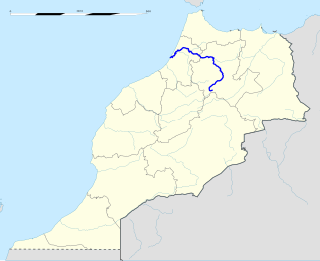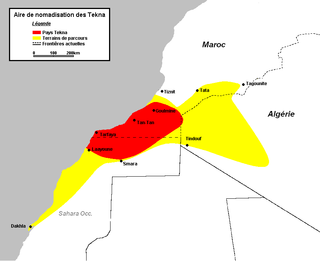Related Research Articles

The Almoravid dynasty was an imperial Berber Muslim dynasty centered in Morocco. It established an empire in the 11th century that stretched over the western Maghreb and Al-Andalus. Founded by Abdallah ibn Yasin, the Almoravid capital was Marrakesh, a city the ruling house founded in 1062. The dynasty originated among the Lamtuna and the Gudala, nomadic Berber tribes of the Sahara, traversing the territory between the Draa, the Niger, and the Senegal rivers.

Moulay Ismail Ben Sharif, born around 1645 in Sijilmassa and died on 22 March 1727 at Meknes, was a Sultan of Morocco from 1672–1727, as the second ruler of the Alaouite dynasty. He was the seventh son of Moulay Sharif and was governor of the Kingdom of Fez and the north of Morocco from 1667 until the death of his half-brother, Sultan Moulay Rashid in 1672. He was proclaimed sultan at Fez, but spent several years in conflict with his nephew Moulay Ahmed ben Mehrez, who also claimed the throne, until the latter's death in 1687. Moulay Ismail's 55-year reign is the longest of any sultan of Morocco.
Beni Ḥassan is a nomadic group of Arabian origin, one of the four sub-tribes of the Maqil Arab tribes who emigrated in the 11th century to the Maghreb with the Bani Hilal and Banu Sulaym tribes.

Senhaja de Srair is a Northern Berber language. It is spoken by the Sanhaja Berbers inhabiting the southern part of the Moroccan Rif. It is spoken in the Ketama area west of Tarifit in the Taza-Al Hoceima-Taounate region

The Sanhaja were once one of the largest Berber tribal confederations, along with the Zanata and Masmuda confederations. Many tribes in Morocco, Western Sahara and Mauritania bore and still carry this ethnonym, especially in its Berber form. Other names for the population include Zenaga, Znaga, Sanhája, Sanhâdja and Senhaja.
Abdallah ibn Yasin was a Moroccan theologian, founder, and first leader of the Almoravid movement and dynasty.
The Lamtuna are a farmer Berber tribe belonging to the Iẓnagen / Sanhaja (Zenaga) confederation, who traditionally inhabited areas from Sous to Adrar Plateau. During the Almoravid period, many Lamtunas emigrated northwards. Currently, the Lemtuna Tribe is based in the South of Mauritania. The chief of this Tribe is Mr. Limam Ould Teguedi (former Minister of Justice, former Minister of culture and former Attorney General of Mauritania. Among notable families, the family of Ehl Aly Ibn Ibrahim and the family of Ehel Sidelemine, Ehl Abdawa, Ehl Mohamed El-Emine, Ehl Mohammed Ghali. Sahrawi Tajakant as well as Messouma tribes are of the most recognisable offshoots of the Lamtunas. They inhabit the area between Morocco and Western Sahara.

Sebou is a river in northern Morocco. At its source in the Middle Atlas mountains it is known as the Guigou River. The river is 496 kilometers long and has an average water flow of 137 m3/s, which makes it the largest North African river by volume. It passes near the city of Fes and discharges to the Atlantic Ocean in Mehdia. Sebou is navigable for only 16 km as far as the city of Kenitra, which has the only river port in Morocco. Its most important tributaries are the Ouergha River, Baht River and Inaouen River. The river supports irrigation in Morocco's most fertile region: the Gharb.

The Tekna is a semi-nomadic Sahrawi tribal confederation of Lamta Sanhaja Berber origins. Its constituents today inhabit southern Morocco and northern Western Sahara, but traditionally with wider migration routes. Nowadays, its population is estimated to be around 709,000.
Shihāb al-Dīn Abu ’l-Abbās Aḥmad ibn Abi ’l-ʿAlāʾ Idrīs ibn ʿAbd al-Raḥmān ibn ʿAbd Allāh ibn Yallīn al-Ṣanhājī al-Ṣaʿīdī al-Bahfashīmī al-Būshī al-Bahnasī al-Miṣrī al-Mālikī, was a Maliki jurist and legal theoretician of Sanhaja Berber origin who lived in Ayyubid and Mamluk Egypt.

Anezzah is an Arabian tribe in the Arabian Peninsula, Iraq, and the Levant. it is estimated that the tribe of Anezzah Has about 22 - 25 million Arabs Traced back to it making it the most populated Tribe in Arabia.
Abd al-Aziz al-Fishtali, fully Abu Faris 'Abd al-'Aziz ibn Muhammad ibn Ibrahim al-Sanhaji al-Fishtali was a Moroccan writer, head of the chancery, official historiographer and official poet of the Sultan Ahmad al-Mansur.
Shihab al-Din abu l-‘Abbas Ahmad ibn Mohammed ibn Mohammed ibn Ahmed ibn Ali ibn 'Abd ar-Rahman ibn Abi'l-'Afiyya al-Miknasi az-Zanati, known simply as Ahmad ibn al-Qadi or Ibn al-Qadi (1552/1553–1616), was a Moroccan polygraph. He was the leading writer from Ahmad al-Mansur's court in Morocco next to Abd al-Aziz al-Fishtali. He was also a renowned judge and mathematician.

The Ifranids, also called Banu Ifran, Ifran, or the children of the Ifran, were a Zenata Berber tribe prominent in the history of pre-Islamic and early Islamic North Africa. In the 8th century, they established a kingdom in the central Maghreb, with Tlemcen as its capital.
Abu al-Qasim az-Zayyani or, in full, Abu al-Qasim ibn Ahmad ibn Ali ibn Ibrahim az-Zayyani (1734/35–1833) was a Moroccan historian, geographer, poet and statesman from the Berber zayane tribe in Morocco. He undertook diplomatic missions to the Ottoman court and engineered government attempts to bring tribes under central authority. His writings include several historical accounts of the Ottoman and Alaouite dynasties. Az-Zayyani wrote fifteen works in the field of history and geography. Some authors even consider him the greatest historian of Morocco.
Abu Abd Allah Muhammad ibn Muhammad al-Ifrani al-Susi al-Marrakushi, called al-Saghir, was a Moroccan historian and biographer.

Al Wahda Dam, formerly known as M'Jaara Dam, is an embankment dam on the Ouergha River near M´Jaara in Taounate Province, Morocco. It was constructed for flood control, irrigation, water supply and hydroelectric power production. It is the second largest dam in Africa and the largest in Morocco. It was described by Land Ocean Interactions in the Coastal Zone (LOICZ) as "the second most important dam in Africa after the High Aswan dam."

Igawawen or Gawawa, mostly known as Zwawa were a group of Kabyle Berber tribes inhabiting the Djurdjura mountains, Greater Kabylia, in Algeria, whose most famous and strongest confederations were those of the Ait Betrun, the Ait Iraten, and the Ait Mengellat, and are divided into various tribes, and the tribes themselves are divided into many villages. The Zouaoua are a branch of the Kutama tribe of the Baranis Berbers.
Abu Yahya ibn al-Sakkak al-Miknasi, was a Moroccan historian, genealogist, judge, Maliki scholar and Sufi mystic. He was born in Fez into the Ibn al-Sakkak family, a Berber family from the Miknasa tribe. He was a friend of Ibn Khaldun, they both studied under al-Sharif al-Tilimsani. al-Sakkak was especially well known as author of an advice to Muslim kings, Nush muluk al-islam bi-al-tarif bi-ma yajibu alay-him min huquq ila bayt al-kiram. In his advice Ibn Sakkak expressed skepticism about the divine right claimed by some rulers in his time.
Zawi ibn Ziri as-Sanhaji or Al-Mansur Zawi ibn Ziri ibn Manad as-Sanhaji, was a chief in the Berber Sanhaja tribe. He arrived in Spain in 1000 (391) during the reign of Almanzor. He took part in the rebellion against the Caliphate of Córdoba and settled in the Cora of Elvira with followers from his Sanhaja tribe. He founded the Taifa of Granada, and founded the Zirid dynasty of Granada as its first Emir, reigning from 1013 to 1019.
References
- ↑ El Mekkaoui, Ahmed (2010). "Sless". In Toufiq, Ahmed (ed.). Ma'lamat al-Maghrib (Encyclopedia of Morocco). Vol. 25. al-Jamī‘a al-Maghribiyya li-l-Ta’līf wa-l-Tarjama wa-l-Nashr. p. 153.